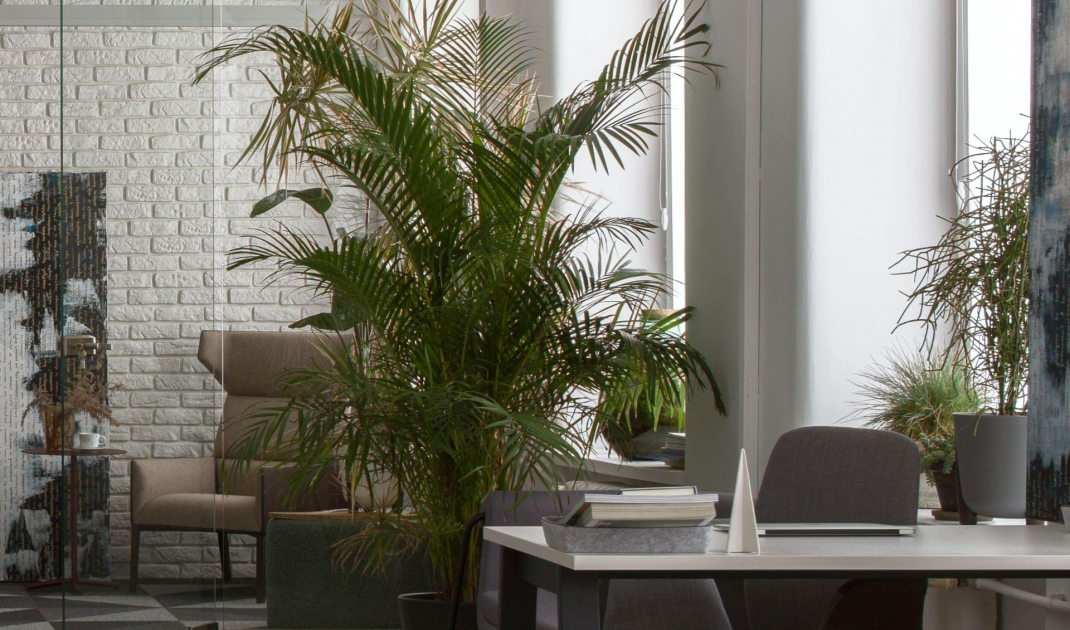It is difficult today to imagine an interior without plants. However, in order to enjoy them for many years and proudly watch them grow, they need to be properly cared for. It is not enough that we water and fertilize them regularly. Equally important in maintaining our houseplants is to make sure they get the right amount of sunlight for the species.
Ask for adequate sunlight for your plants
Photo: Yassen Hristov Styling: Agnieszka Możdzer © Tomaszewski
Plants for shady and semi-shaded places
Shaded and semi-shaded places in interiors are those that are about 3-4 meters across from the window, as well as east and north window sills shaded by trees or neighboring buildings. Plants that tolerate shady corners of the apartment well usually grow in nature in the forest canopy. These include species such as Epipremnum, Aspidistra, Hedera, Wingflower, Kencja, Monstera, and Aglaonema. Zamioculcas and Sansevieria are species that are also tolerant of lack of sun, but in the wild they inhabit heavily sunny areas. Note that only aspidistra and kencja are pet-friendly. The others listed will be poisonous to our pets once eaten. Most of the above-mentioned shade and semi-shade plants have been in our interiors for years. Among them, the Monstera is extremely popular. Its large, green and distinctive leaves inspire interior decorators and designers. This plant has become extremely fashionable not only because of its decorative qualities, but also because it is one of the easiest houseplants to grow. However, it needs a little more free space, as it can grow to a really large size. Equally popular indoors is Zamioculcas, which owes its popularity to its extremely low light and water requirements. This is a plant for people with little time and experience in growing decorative flowers, but who like beautiful green interiors.
For shady places choose Epipremnum, Aspidistra, Hedera, Wingedflower, Kena, Monstera or Aglaonema.
Photo: Yassen Hristov Styling: Agnieszka Możdzer © Tomaszewski
Plants for forbidden places
On the other hand, the forbidden places are those with the so-called diffused light - about 1-3 m from the window, as well as window sills located in the eastern and northern directions. These positions are ideal for all green plants. However, there are some that, for proper growth, can have no other location than precisely that with bright, diffused light. Among them are Areca, Ficus lyrata and other ficus, ferns such as Asplenium, Calathea, Pilea, Diffenbachia, Peperomia, Syngonium, Allocasia, Hoja, Croton, Bosslera, Zielista, Banana plant, for example. They are extremely decorative, and depending on what decorative effect we want to achieve, we can choose from plants with different shapes, sizes and colors of leaves. Thus, for example, if we prefer green plants with full height foliage, we can choose freely from a full range of ficus. These are slender plants that take up little space, such as Ficus lyrata. Its large leaves resemble violins or lyres in their shape. At the same time they are slightly shiny with clearly visible innervation. Very impressive, usually carried on a single shoot, slender, tall like a column will become a decoration of any interior. Lovers of beautiful foliage will certainly not pass indifferently to Calathea. Their unique patterns and colored nerves make them some of the most beautiful ornamental plants we can grow in our homes. And although Calatheas are among the capricious and demanding plants, they are worth the proverbial effort.
In a bright spot put Asplenium, Calathea, Pilea, Diffenbachia, Peperomia, Syngonium, Allocasia, Hoja, Croton, Szeflera, Zielista, Banana plant.
Photo: Yassen Hristov Styling: Agnieszka Możdzer © Tomaszewski
Plants for sunny places
The last of the described types of places for plants in our houses and apartments are sunny places - mainly window sills of southern and western windows, as well as places directly next to the windows - at a distance of about 1-1.5 meters. The choice of light-loving plants is definitely larger than those that we can put in shady places. These include Livinstona, Date Palm, cacti, succulents, Nolina, Senecio rowleyanus, Strelitzia, or Sansevieria, among others. Succulents are extremely popular. These are plants that have the ability to store water, so they can survive even long periods of drought. Most of them are ideal for a sunny windowsill. They need a sunny and dry atmosphere, tolerate heating, and grow best just on a hot site.
Liwinstona, Date Palm, cacti, succulents, Nolina, Senecio rowleyanus, Strelitzia, or Sansevieria need plenty of sun.
Photo: Yassen Hristov Styling: Agnieszka Możdzer © Tomaszewski
Are you decorating your apartment? We have more inspiration for you!
Compiled by:KATARZYNA SZOSTAK






























